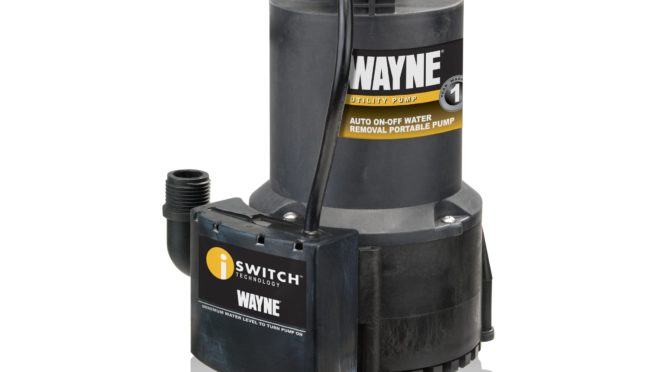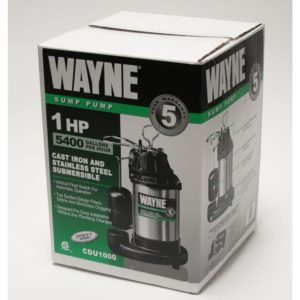 Many homeowners realize that a good sump pump (e.g., the Zoeller M267) is a necessity for reducing the risk of basement flooding. A few savvy ones also realize a DC backup pump (e.g., the Wayne WSM3300) is worth its weight in gold during a power outage. However, very few homeowners realize that there are a range of other sites in, on, and and around a home where water can pool and cause damage via rotting or flooding. Crawlspaces, window wells, flat roofs, boats, stock tanks, low areas in driveways, and similar areas can quickly accumulate water and lead to property damage or mosquito and vermin problems. Fortunately, there are a number of quick, cheap, and effective solutions for dealing with standing or pooling water around the home.
Many homeowners realize that a good sump pump (e.g., the Zoeller M267) is a necessity for reducing the risk of basement flooding. A few savvy ones also realize a DC backup pump (e.g., the Wayne WSM3300) is worth its weight in gold during a power outage. However, very few homeowners realize that there are a range of other sites in, on, and and around a home where water can pool and cause damage via rotting or flooding. Crawlspaces, window wells, flat roofs, boats, stock tanks, low areas in driveways, and similar areas can quickly accumulate water and lead to property damage or mosquito and vermin problems. Fortunately, there are a number of quick, cheap, and effective solutions for dealing with standing or pooling water around the home.
We’ve reviewed a number of Wayne-based sump pumps in the past and have had positive experiences with the majority of them, such as with combination AC/DC sump pumps like the WSSM40V, WSS30V, and WSS20V, DC sump pumps like the WSM3300, ESP25, and ESP15, and AC pumps like the CDU1000, CDU980E, and CDU800. Today we’ll take a look at a close cousin to the AC pumps, a utility pump called the Wayne EEAUP250 1/4 HP Water Removal Pump. Our goal was to find out how good of a job it did clearing water as well as its short-and long-term reliability and overall value. We’re of the opinion that it’s a darn good pump. Our full review is below, but if you’re wondering whether or not to buy it, we recommend it, and you can buy it here.
Key Features of the Wayne EEAUP250 Utility Pump (60 Second Summary)
 The Wayne EEAUP250 is an automatic utility pump marketed as an electric water removal pump. Practically speaking, it’s an on-demand sump pump for window wells and other areas prone to flooding. It has a 100 volt corded 1/4 HP motor with a max flow rate of 3,000 gallons per hour; this drops to 2,600 GPH at 5 feet, 1,850 GPH at 10 feet, and it is inoperative by 15 feet. It can remove water to within 3/8 inches of a surface.
The Wayne EEAUP250 is an automatic utility pump marketed as an electric water removal pump. Practically speaking, it’s an on-demand sump pump for window wells and other areas prone to flooding. It has a 100 volt corded 1/4 HP motor with a max flow rate of 3,000 gallons per hour; this drops to 2,600 GPH at 5 feet, 1,850 GPH at 10 feet, and it is inoperative by 15 feet. It can remove water to within 3/8 inches of a surface.
Being automatic, it does not require monitoring when removing water and can be left unattended to start and stop as needed when water is present. It is also submersible. It includes a 1-1/4 inch discharge with a 3/4 inch-sized garden hose adapter. The EAUP250 comes with a 1 year warranty. It weighs 9.3 pounds and is 6.5 inches in diameter and 12 inches tall.
How Does the Wayne EEAUP250 Compare to the Wayne WWB WaterBug and Zoeller 42-0007 N42 Utility Pumps?
The main differences between the Wayne EEAUP250, the Wayne WaterBug, and the Zoeller N42 utility pumps lie in automaticity, power, speed, max head (the height to which water may be pumped against gravity), and minimal water removal. Regarding automaticity, the EEAUP250 is the only automatic pump on the list; the other two pumps must be manually turned on and off to operate, while the EEAUP250 senses water levels and runs only until it reaches the water cutoff height at 3/8 inch. This factor alone is enough to sell it over the competition.
The EEAUP250 includes the most powerful motor at 1/4 HP vs 1/6 HP in both the WaterBug and the N42. While the EEAUP250 can pump up to 3,000 GPH, the WWB tops out at 1,257 GPH and the N42 can’t move more than 900 GPH. However, while the EEAUP250 shuts off by 15 feet, the N42 doesn’t shut off until 19 feet while the WWB keeps going up to an impressive 30 feet. Similarly, when it comes to minimal water removal, the EEAUP250 at 6/16 inch comes in last behind the N42 at 2/16 inch and the WWB at 1/16 inch.
Our Short and Long Term Experiences Installing and Using the Wayne EEAUP250 Utility Pump
 Installing the EEAUP250 is about as easy as a plumbing task can get, even with next to no plumbing experience. You essentially plug it in, connect it to a garden hose at 3/4 inch or a 1-1/4 inch tubing, and you leave it to go to work. Because it automatically sense water levels, there was no need to babysit it or keep track of where water was pooling and how much would need to be pumped; we simply dropped the EEAUP250 anywhere it was needed and it got to work. We tried it in crawl spaces, window wells, emergency egresses, on flat roofs, and in a range of other areas where water was accumulating, and it diligently whirred away until reaching its 3/8 inch lower bound. We did notice that it typically took up to 2 inches of water surrounding the pump before it self-activated.
Installing the EEAUP250 is about as easy as a plumbing task can get, even with next to no plumbing experience. You essentially plug it in, connect it to a garden hose at 3/4 inch or a 1-1/4 inch tubing, and you leave it to go to work. Because it automatically sense water levels, there was no need to babysit it or keep track of where water was pooling and how much would need to be pumped; we simply dropped the EEAUP250 anywhere it was needed and it got to work. We tried it in crawl spaces, window wells, emergency egresses, on flat roofs, and in a range of other areas where water was accumulating, and it diligently whirred away until reaching its 3/8 inch lower bound. We did notice that it typically took up to 2 inches of water surrounding the pump before it self-activated.
In the long term, we’d expect the average user to get several years out of the EEAUP250. It’s made of plastic, which is often a strike against longevity in tasks involving water, pressure, and shock, but it’s designed well and is likely to provide worry-free functionality for many years as long as cared for reasonably; we look into this further below.
Troubleshooting and Installation Tips to Get Your Wayne EEAUP250 Working Sooner
Perhaps the most key point to remember regarding the EEAUP250 is that it cannot be left outside year round. Doing so will freeze the pump–or specifically, the water around the pump, which will then crack the thermoplastic case and break both the pump and the impeller.
Although it’s not required, you might want to connect a check valve to your hose to prevent back flow (the water in the hose flowing back into the pump); this can result in needless on and off cycling of the pump due to water flowing back into it and triggering it on repeatedly.
If you choose to install the sump pump in a window well, you might want to consider digging a small hole in the well (e.g., 4-5 inches) and placing a plastic bowl or basin of equal height (with several holes drilled into the sides and base of the basin) in the hole before placing the pump inside the basin. This will allow water to flood the basin and activate the pump significantly before the water reaches the window well’s ground level. This technique effectively makes a miniature sump pit within your window well and will significantly reduce water accumulation within the window well itself.
Wayne EEAUP250 Utility Pump Pros, Cons, and Value Comparison
In conclusion, while the Wayne EEAUP250 may not be the most feature-filled utility pump on the market, it’s small, affordable, reliable, and capable of pumping a decent amount of water without fuss. We’re particularly pleased with its auto-on/off functionality and the ease with which the average person can install it. If you need to clear out water from your window well, rooftop, or similar area, this is the pump to get.
You can buy the Wayne EEAUP250 here on Amazon. You can buy the Wayne WaterBug here. You can buy the Zoeller 42-007 here. You can buy a universal check valve kit here and a discharge hose kit with clamps here.
If you find our work at PumpThatSump helpful, you can support our relentless reviewing of every sump pump on the market by shopping via our Amazon link for whatever you need to make your house a home. Despite being self-employed, we promise not to spend it all on health insurance.




